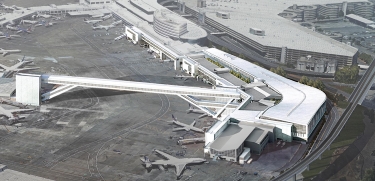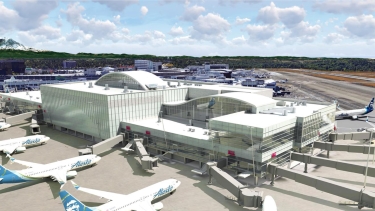|
Subscribe / Renew |
|
|
Contact Us |
|
| ► Subscribe to our Free Weekly Newsletter | |
| home | Welcome, sign in or click here to subscribe. | login |
Construction
| |
August 14, 2017
Port seeking another $213M for IAF, North Satellite at Sea-Tac
Journal Construction Editor
The Port of Seattle breaks ground tomorrow on its International Arrivals Facility at Sea-Tac Airport, and on the same day the port commissioners will vote to authorize another $105.6 million for the project as well as another $107.5 million for the North Satellite expansion.
If approved, the IAF budget will grow to $766 million and the North Satellite budget will hit $658 million.
A port document listed the largest part of the proposed increase in the IAF progressive design-build contract as $29.6 million for an “understated initial estimate.”
A port spokesman said about $15 million of that is for special systems, such as HVAC, plumbing and electrical. The rest is for underestimating the cost of concrete and earthwork.
Here are the other cost increase factors for IAF: $22 million for design evolution; $20 million for added scope; $15 million for “other required costs”; $14 million for market conditions; and $5 million for schedule/phasing complexity.
The North Satellite expansion is a general contractor/construction manager project. Its cost increases include $22 million for understated initial estimate and design evolution, which the spokesman described as similar to those for the IAF.
An example of a cost increase at the North Satellite given by the spokesman is having Hensel Phelps, the GC/CM, increase the size of a temporary heater/chiller pipe from 10 inches to 16 inches to keep operations going while construction is underway.
The document shows the largest cost increase for the North Satellite is $24 million for market conditions/contractor availability, followed by $23 million for schedule/phasing complexity and $21 million for added scope.
The document cites subcontractor and labor shortages, the lack of qualified labor and contractors choosing easier projects.
Another $12 million is being sought for other costs, such as taxes and security screening for workers, and $5 million for “replenishment of management reserves.”
Construction started in February on the North Satellite. It will open in the third quarter of 2021, and substantial completion is scheduled for early 2022.
The reworked terminal will be 201,000 square feet larger, with eight new gates, an upper-level mezzanine, twice as much dining and retail space, and a rooftop lounge for Alaska Airlines.
The transit system lobby will be refreshed and new escalators to trains will be installed.
The IAF is expected to open in late 2019. Clark Construction Group is building the 450,000-square-foot multi-level facility that will wrap around the east side of Concourse A.
The IAF will connect to the South Satellite terminal by a 900-foot-long pedestrian bridge that will sit 85 feet above an active taxiway. Arriving passengers at the South Satellite will travel across the bridge and over Concourse A to customs inside the IAF.
The port says the new IAF is needed because the 1970s-vintage arrivals facility in the South Satellite is beyond its peak capacity.
According to the port, the new facility is expected to meet growing demand for international service, as well as enhance the passenger experience and advance the Puget Sound region as a tourism/business gateway. It is expected to double capacity, to 2,600 passengers per hour.
The new IAF is also increasing the number of international gates from 12 to 20, passport check booths from 30 to 80, and bag claim carousels from four to seven.
The IAF's design-build group includes architecture firms Skidmore, Owings & Merrill and The Miller Hull Partnership. Engineers are Arup (mechanical/electrical/plumbing), KPFF (structural) and MKA (civil). Schlaich Bergermann Partner is the bridge designer.
Sea-Tac Airport is the ninth busiest U.S. airport, serving nearly 45.7 million passengers in 2016. It is home to 24 airlines that serve 81 non-stop domestic and 24 international destinations.
Benjamin Minnick can be
reached by email or by phone
at (206) 622-8272.




